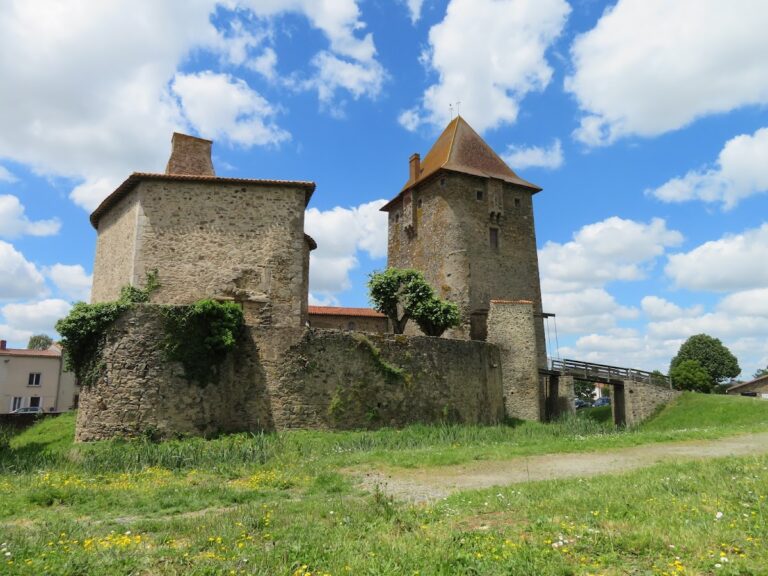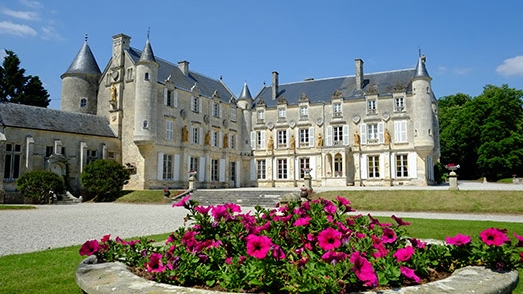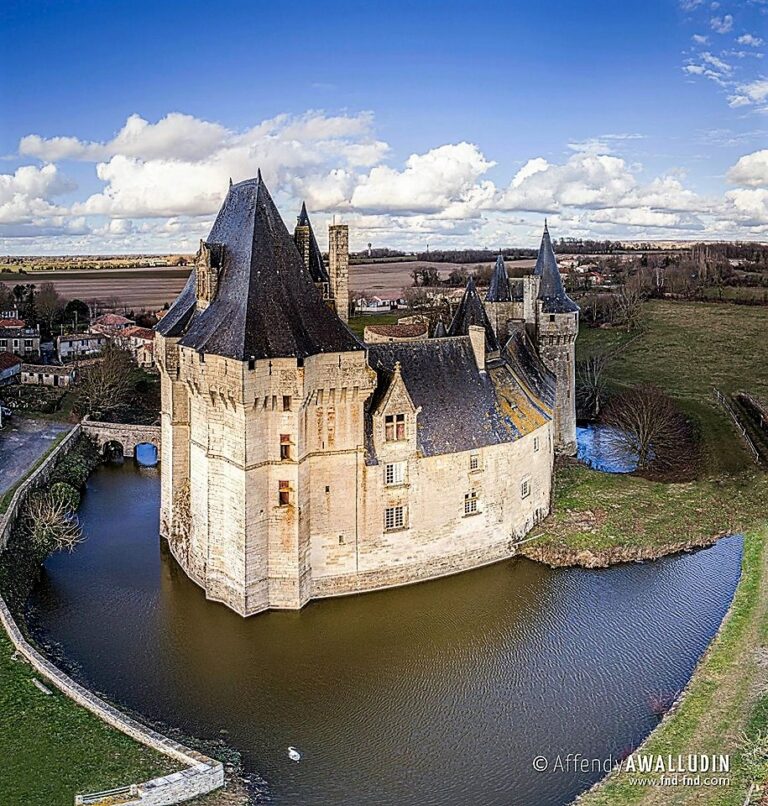Château de Saint-Mesmin: A Medieval Fortress in Saint-André-sur-Sèvre, France
Visitor Information
Google Rating: 4.7
Popularity: Low
Google Maps: View on Google Maps
Official Website: www.chateau-saintmesmin.com
Country: France
Civilization: Medieval European
Remains: Military
History
The Château de Saint-Mesmin is situated in the municipality of Saint-André-sur-Sèvre, France, near the border with the Vendée. This medieval fortress was constructed by French nobility during the 14th century, built to serve as a fortified residence in a border region marked by political and military tensions.
The castle’s early history is closely tied to the Montfaucon family, who held the lordship from at least 1276. They served as knights under the overlordship of the Larchevêque family from Parthenay. Around 1370, Pierre de Montfaucon undertook a major rebuilding of the castle in response to royal orders issued in 1367, which demanded that fortifications be strengthened to resist siege warfare. During the years 1372 to 1375, he invested in significant defensive works and restorations, reaffirming the castle’s role as a military stronghold.
Shortly after these enhancements, in 1375, a conflict arose with Guillaume Larchevêque, the regional lord. This dispute ended with an agreement granting Larchevêque the right to demolish the castle at his discretion. Following this accord, Larchevêque’s men attacked the fortress, causing extensive damage and looting valued at around 1,000 livres parisis. Legal battles between the Montfaucon and Larchevêque families continued for several years, lasting at least until 1380. During this period, regional power dynamics shifted, including the involvement of Arthur de Richemont, a notable count and military leader.
The Montfaucon dynasty concluded in 1548 with the death of Louise de Montfaucon. The castle then passed through marriage alliances to the du Plessis de La Bourgognière family and later, in 1575, to the Vaudrey de Saint-Phal family, who maintained ownership until the mid-17th century. In 1577, King Henri III granted feudal privileges to the castle’s seigneury, allowing it to host fairs, markets, and organized hunts, signaling its role in the local economy and social life.
A change in ownership occurred in 1650 when Gilbert Petit bought the estate. His family elevated the property to the status of a marquisate by 1705. Documentation from 1714 and 1734 describes the castle as a richly appointed noble residence, featuring numerous bedrooms, tapestries sourced from renowned centers such as Bergamo, Flanders, and Aubusson, as well as amenities like a billiard room, stables, an orangery, and a chapel bearing the Petit family’s coat of arms dated to 1714.
In 1755, the castle changed hands again, becoming property of the de Vasselot family. Less than a decade later, by 1766, the family had abandoned the residence. During the upheavals of the French Revolution, the Château de Saint-Mesmin was confiscated and sold as national property in 1798. The castle suffered further during the Vendée Wars, a royalist and Catholic insurrection, notably during the “colonnes infernales” military campaigns in 1794 and a subsequent military engagement in 1796.
The Proust family acquired the property in 1818, maintaining possession for nearly two centuries until 1990. During the First World War, from 1914 to 1915, the castle was repurposed as a convalescent hospital accommodating up to 59 wounded soldiers. Those with contagious diseases were isolated within the castle, while others were cared for in the orangery. The fortress chapel was temporarily reinstated for religious purposes during this time.
In 1990, stewardship of the Château de Saint-Mesmin was transferred to the Association du Château de Saint-Mesmin, which began restoration projects and opened the site to the public by 1992. Officially recognized as a historic monument in 1993, the castle underwent major restoration efforts, especially after the collapse of the seigneurial residence in 1983. Since 2003, a cooperative syndicate of local authorities from Deux-Sèvres and Vendée has managed the site, continuing restoration work supported by national, European, and regional funds, aimed at preserving the structure and revitalizing its cultural heritage.
Remains
The Château de Saint-Mesmin presents as a 14th-century medieval fortress carefully designed with a distinctive hexagonal layout. This enclosed perimeter, known as an enceinte, is surrounded by moats filled with water sourced from the nearby Sevreau stream, reflecting the strategic use of natural defenses.
Originally, the enceinte was guarded by seven horseshoe-shaped towers, a defensive shape providing a wide field of fire. Today, five of these towers remain intact, including two that flank the main entrance, forming a fortified gateway or châtelet. This main gate once featured a drawbridge spanning the moat and a pointed arch entrance, strengthening the castle’s protection during sieges.
In the 15th century, structural changes included replacing one of the horseshoe towers with a tall donjon, standing 28 meters high. This keep or main tower is topped by a chemin de ronde, a roof walkway for patrols, with machicolations—stone openings projecting outwards allowing defenders to drop objects or fire upon attackers below. The donjon remains uncovered on the roof but was updated with cannon openings at every level, signaling an adaptation to emerging artillery warfare.
Defensive architecture throughout the castle includes narrow vertical openings called arrow slits or archères, designed for longbows, and wider crossbow slits or arbalétrières. Evidence of the original drawbridge mechanism still survives, underscoring the castle’s emphasis on controlled access and security.
By the 17th century, modifications shifted focus toward comfort, with installations such as new windows, doors, chimneys, flooring tiles, and roofing materials. These changes illustrate the castle’s gradual transition from a purely military stronghold to a noble family’s residence.
Interior descriptions from early 18th-century inventories reveal about fifteen bedrooms, a salon, and a large hall equipped with a billiard table. Functional kitchens, bakery, laundry, storage rooms, and a small study are noted, along with numerous fireplaces outfitted with ironwork tools like andirons and fire tongs. Rich tapestries from regions celebrated for textile art—including Bergamo, Flanders, and Aubusson—decorated the rooms, signaling status and refined tastes. The estate also maintained carriage horses, an orangery for cultivating citrus plants, and a separate chapel at the Ville site. The chapel’s arched door carries the sculpted Petit family coat of arms dated 1714.
After being largely abandoned in the 18th century, the castle’s moats were drained. In 1983, a severe storm caused the complete collapse of the seigneurial residence, prompting urgent conservation efforts in subsequent decades.
Recent restoration has involved waterproofing the fortress, stabilizing and repairing farmstead wings around the courtyard, including new framing and roofing work on the north wing, and refurbishing interiors. The entrance châtelet, as well as the central and south wings of the farm structures, have been carefully restored. The staircase in the donjon has also been rehabilitated, allowing safer access to upper levels. The north-east wing of the castle benefited from restoration between 2021 and 2022.
Today, the Château de Saint-Mesmin stands as a well-preserved example of medieval military architecture blending with later residential adaptations. Its surviving towers, fortified gate, and donjon remain key features, all supported by ongoing conservation that honors the layered history embedded in its stone walls and surrounding moat.










